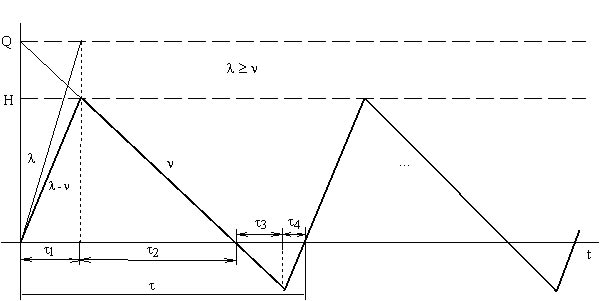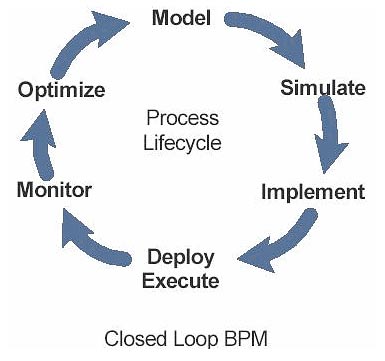2.1 Model of inventory control
Input parameters of model:
n - intensity of demand;
l - intensity of manufacture of the order;
s – storage costs;
d - the penalty for deficiency;
K – cost of order placement.
Output parameters of model:
Q - the size of the order;
t - the period deliveries;
t i duration of i-stage of a cycle of stock change;
L – total costs for storekeeping per time unit;
м - maximal level of a stock;
h - maximal level of deficiency.
The given model is based on an assumption that exists production in which at the first stage the party is made production with intensity l which are used at the second stage with intensity n (fig. 2.1).

Figure 2.1 - The circuit of production
In model outstanding orders are gathered and immediately satisfied in process of new receipts.
Duration of a cycle of stock change t is divided on 4 stages:
-
t 1 - the ordered product is made, the made product is consumed, the stock collects;
-
t 2 - the ordered product is not made, the stock is consumed, the stock decreases to zero;
-
t 3 - the ordered product is not made, the stock is empty, outstanding orders are gathered, deficiency increases;
-
t 4 - the ordered product is made, backlog is carried out, the stock is absent, deficiency decreases to zero.

Figure 2.2 - the Scheme of change cycles of stocks in the generalized model OUSE
Formulas of model:




2.3 Methods of service logistics
We shall allocate stages of formation of logistical service systems:
-
Segmentation of the consumer market, i.e. its division into concrete groups of consumers, for each of which can be demanded the certain services according to features of consumption.
-
Definition of the list of the most significant services for their buyers.
-
Ranging of the services which are included in list, on the importance for buyers, a concentration of attention on the most significant services.
-
Definition of service standards for separate segments of the market.
-
The estimation of rendered services, establishment of interrelation between service level and cost of rendered services, definition of service level necessary for maintenance of competitiveness of the company.
-
The establishment of a feedback with buyers for maintenance of service conformity to requirements of buyers.
The important criterion is level of logistical service. It allows to estimate generally service system, both from a position of the supplier and buyer. Calculation of the given parameter is determined under the following formula

where
N - level of logistical service;
m - quantitative estimation of theoretically possible volume of logistical service;
M - quantitative estimation of actually rendered volume of logistical service.
2.4 Fusion of enterprise processes to corporate system
It is desirable to have adaptive business - processes which can be adjusted and optimized, to correspond to changing conditions of business, normative requirements of the legislation and competition pressure. This desire has led to control systems of full cycle business - processes (closed loop Business Process Management (BPM) systems). Oracle BPEL Process Manager + tools of of other manufacturers modeling is full and easy platform in application for designing and expansion of full cycle BPM-decisions.

Figure 2.3 – The full cycle BPM-decision
Life cycle of process will consist of the following steps or problems:
-
Modeling of process (model the process) - during this step owners of business - processes create high-level the model consisting of tasks which should be carried out, and necessary resources for this purpose. Besides some assumptions of performance time and cost of each task are made.
-
Imitation and the analysis (Simulate and Analyze) - received high-level model is used for "run" of some hypothetical scripts with the purpose of detection of critical parts (paths) and “narrow necks” (bottlenecks). The received information is applied to adjustment{option} of process before its expansion.
-
Introduction and documenting (Implement and document) - during this step high-level business - process, actually its description of a high level, will be transformed to model of executed process. Process is documented for being used for training and support in the future.
-
Expansion and execution (Deploy and Execute) - this step includes expansion of process for BPM-"cursor" (BPM-engine) and its execution for realization through streams [managements and the data] between systems and people.
-
Monitoring (Monitor) - during this step occurs monitoring business - processes with the purpose of key indicators reception. This step executes, as a rule, with application of business -activity monitoring means (Business Activity monitoring tool) together with BPM-"cursor".
-
Optimization and redesign (Optimize and Redesign) - after monitoring of the system received metrics can be used for the further process optimization. Real throughput of process and the metrics of use can be entered into the tool of imitation to receive optimum executive model.
3 DEVELOPMENT EFFICIENT ACTIVITY MODEL OF THE ENTERPRISE
Classical MRP-2 task considers planning product and its cost price only from the position of internal manufacture. In classical systems this problem is partly eliminated by attracting of design planning methods. However they are usually insufficiently flexible and integrated into the basic system of planning.
It turns out, that except for actually industrial costs, should be taken into consideration and planned marketing costs, presale preparation and costs of after sale cycle. Generalizing, it is possible to ascertain, that resources should be planned and supervised during all life cycle of the goods. And in this case under life cycle is understood the functional life cycle of the goods against widely known marketing life cycle.
Usually life cycle of the goods is considered only from position of its stay in the market (marketing life cycle).
One of the vital issues essentially affecting on a condition of the manufacture in conditions of competition is an essential reduction of the most economic stages of life cycle. Among them are stage of growth and especially a stage "plateau" - steady demand. In the following figure these changes are shown.
Such situation has led to essential attention to other approach of life cycle estimation, through functional life cycle: the goods, logistic, marketing and service.
This approach affects in many aspects of management and estimation of activity of the enterprise. In particular, cost of the goods is the most important for considering of full life cycle, To plan activity also important during full life cycle.
MRP and ERP systems include the most part of a production cycle, a part of a logistical cycle, from position of planning and management in cost. Though in some systems service systems are supported and configuring, but they as a rule are poorly integrated with other parts of system.
A qualitative monitoring after integration processes at the enterprise, assumes allocation of efficiency parameter of system functioning G. Further updating
administrative decisions can consist of development of managing influence u=F (z),
compensating indignation z , and directed on deviation minimization of efficiency parameter k=G (u, z).
CONCLUSIONS
According to level of evolutionary development of the enterprise, there should
be improved administrative processes on it. The traditional approach to
resource management at the enterprise corresponds to chaos level.
It means, that a problem of through material stream improvement (an element
system level), has no priority value for each of enterprise divisions. Parameters of material stream on output are difficult predicted and as consequence are far from optimal. The reason is that administrative processes at enterprises are of “pushing type ”, when the ready product is made without taking into account requirements and concrete terms of its realization.
Thus, transition of the enterprise to “pulling type”, supposing performance
the order in time for satisfaction of concrete need, cannot be feasible without fusion into economic system. The means that provides effective reaction to changes of environment, it is possible to relate the following opportunities of the enterprises: the analysis of an environment, an establishment of communication with potential buyers,
the analysis of market condition, promotion and realization of competitive ideas,
maintenance of independence of the enterprise from change of a conjuncture of commodity markets, maintenance of the competitive status.
The LIST OF REFERENCES
- Колесников С.Н. Стратегии бизнеса: управление ресурсами и запасами. - Москва, «Статус-Кво 97», 2000
- Захаров С.И. Информационная интегрированная поддержка управлением цепями поставок торговой компании // Логистика и управление цепями поставок. - №2-3 сентябрь - 2004.
- Черненко М. Проблемы управления украинскими предприятиями. // Корпоративные системы, 2002, № 4. -www.cs.comizdat.com
- Верников Г. Стандарт MRPII. Структура и основные принципы работы систем поддерживающих этот стандарт. -http://citforum.univ.kiev.ua/cfin/mrp/mrp2systems.shtml
- Хруцкий Е. А. Оптимизация хозяйственных связей и материальных запасов (Вопросы методологии). – М.: Экономика, 1997. – 263 с.
- Лысенко Ю.Г. Экономика и кибернетика предприятия: Современные инструменты управления: Монография. - Донецк: ООО «Юго-Восток, Лтд», 2006.- 356 c.
- Хэнссмен Ф. Применение математических методов в управлении производством и запасами. – М.: «Прогресс», 1966.
- Сербин В.Д. Основы логистики (Учебное пособие). - Таганрог: «ТРТУ», 2004.
- Румянцев К. Концепции построения ERP-систем на предприятии. -http://citcity.ru/11208/
- Стерлигова А.Н. Систематизация элементов моделей управления запасами в звеньях цепей
поставок // Логистика и управление цепями поставок. - №4. – 2005. – М.: ГУ-
ВШЭ, 2005. – С. 36-54.